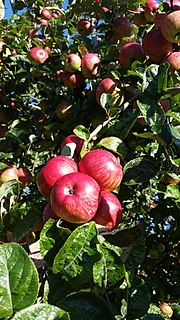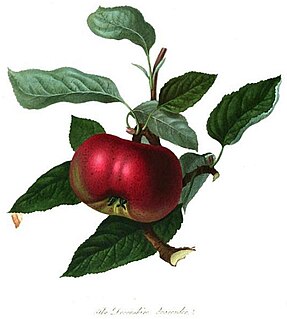| 'Hangdown' | |
|---|---|
| Species | Malus domestica |
| Origin | |
The Hangdown, also known as Hangydown, Horner, or the Pocket Apple, [1] is a traditional variety of cider apple grown mostly in Somerset and North Devon. [2]
| 'Hangdown' | |
|---|---|
| Species | Malus domestica |
| Origin | |
The Hangdown, also known as Hangydown, Horner, or the Pocket Apple, [1] is a traditional variety of cider apple grown mostly in Somerset and North Devon. [2]
A small to medium-sized, yellow-skinned apple of round or slightly cylindrical shape, [1] Hangdown is most easily identified by the tree's habit, which is compact, with twiggy branches that droop heavily when in full fruit. [2] Its origin is unknown, but it was possibly first grown in the Glastonbury area of Somerset. [3] It was also widely grown in Devon, where it was often given the name "Pocket Apple".
In the classification of cider apples the Hangdown is referred to as a (mild) bittersweet type, [3] and is considered to be a 'vintage' variety, i.e. capable of making single-varietal cider. It is scab-susceptible.
Although Hangdown is rarely present in modern commercial orchards, it was once one of the varieties recommended by the Long Ashton Research Station for cidermaking, and is still present in 'trial' orchards outside its native area. [2]
There are a number of closely related varieties, such as the "Improved Hangdown", also known as "Improved Horner" or "Osier", which was sourced by Long Ashton from the Wedmore area in around 1900. [4] Some of these varieties are likely seedlings of the original, sharing the same type of fruit and drooping habit.
Perry is an alcoholic beverage made from fermented pears, similar to the way cider is made from apples. It has been common for centuries in England, particularly in the Three Counties ; it is also made in parts of South Wales and France, especially Normandy and Anjou. It is also made in Commonwealth countries such as Canada, Australia and New Zealand.
Cider apples are a group of apple cultivars grown for their use in the production of cider. Cider apples are distinguished from "cookers" and "eaters", or dessert apples, by their bitterness or dryness of flavour, qualities which make the fruit unpalatable but can be useful in cidermaking. Some apples are considered to occupy more than one category.

The Apple Wassail is a traditional form of wassailing practiced in the cider orchards of southern England during the winter. There are many well recorded instances of the Apple Wassail in the early modern period. The first recorded mention was at Fordwich, Kent, in 1585, by which time groups of young men would go between orchards performing the rite for a reward. The practice was sometimes referred to as "howling". On Twelfth Night, men would go with their wassail bowl into the orchard and go about the trees. Slices of bread or toast were laid at the roots and sometimes tied to branches. Cider was also poured over the tree roots. The ceremony is said to "bless" the trees to produce a good crop in the forthcoming season. Among the most famous wassail ceremonies are those in Whimple, Devon and Carhampton, Somerset, both on 17 January.

The Kingston Black, also known as Black Taunton, is a cultivar of apple originating from the United Kingdom and used in making cider. The name of the cultivar comes from the apples' dark red or purplish skin, though despite the name, the fruit does not have a black hue.
'Brown Snout' is a 19th-century cultivar of cider apple originating in Herefordshire in the United Kingdom, though now grown in other counties and parts of the world.

The Foxwhelp is a very old cider apple cultivar, originating in the west Midlands of England.

The Styre or Stire, also known as the Forest Styre, was an old English variety of cider apple which was formerly common in the Forest of Dean. It is currently thought to be extinct, but may still survive in old orchards or gardens.

The Redstreak, also spelt Redstrake, Red Streak or Red-streak, is or was a very old variety of cider apple formerly commonly planted in England.

'Tom Putt' is a traditional variety of dual purpose apple, often used as a cider apple, originating in Devon. It was also known as Ploughman, Coalbrook, Marrowbone, Thomas Jeffreys and by many other local names.

Slack-ma-Girdle is an old variety of cider apple formerly widely grown in the South-West of England. It is one of a group of similar and closely related varieties all often known by the name "Woodbine".
Crimson King, also known as John Toucher's or the Bewley Down Pippin, is a traditional cider apple cultivar originating in Somerset.
Dufflin is an old variety of cider apple from the County of Cornwall, England. It was included in orchard trials by Long Ashton Research Station in 1957.
Ellis Bitter, also called Ellis's Bitter or Ellis's Bitter-Sweet, is an English cider apple originating in Devon, but now widely planted across the west of England.
The 'Chisel Jersey' is a cultivar of cider apple originating in Somerset.
Michelin is a variety of cider apple commonly grown in commercial orchards in the United Kingdom, although originating in France.
The Coccagee, also spelt 'Cackagee' or 'Cockagee' and sometimes known as the 'Irish Crab' or 'Lord Cork's Crab', is or was a variety of cider apple, known in Ireland and the West of England.
Yarlington Mill is a traditional cider apple cultivar originating from the village of Yarlington, in the North Cadbury area of Somerset, England.
Major is a cider apple cultivar first grown in the United Kingdom in the area of Devon and Somerset.
Cap of Liberty, also known by the name Red Soldiers or Bloody Soldier, is a traditional cider apple cultivar originating in the Martock area of central Somerset.

The Devonshire Quarrenden is a dessert apple cultivar historically grown and probably originating in England, although it has also been suggested as originating in France. A variety of local names and spellings, including "Red Quarrenden", "Quarrington", "Quarender", and the "Sack Apple", have been recorded in the past.